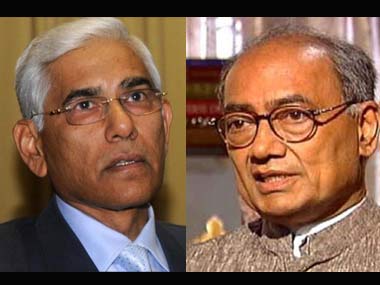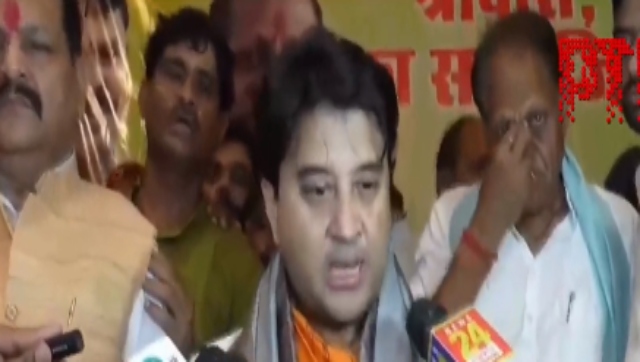Congress loud-mouth Digvijaya Singh has been at it again, this time lambasting a constitutional authority like the Comptroller and Auditor General (CAG).
Among other things, Singh has been quoted by The Indian Express as alleging that CAG’s boss Vinod Rai has political ambitions, and that his loss figures are fiction. He said: “The way the CAG is going, it is clear he has political ambitions like TN Chaturvedi (a former CAG who later joined the BJP). He has been giving notional and fictional figures that have no relevance to facts. How has he computed these figures? He is talking through his hat.”
Singh’s direct attack on the CAG is not surprising since no less person than Manmohan Singh has done the same thing, and in Parliament (read his full speech here ).
So if anyone is “talking through his hat” it is the two Singhs, and not Vinod Rai. However, it is worth sifting through the various criticisms that have been levelled against the CAG so that we can really sort out fact from fiction.
Critiques of CAG reports – whether on the 2G, coal blocks, or Delhi airport irregularities – have taken on three lines of reasoning: one, that the losses projected are wrong or non-existent; two, that the CAG is intruding into policy areas and exceeding its constitutional mandate; and, three, that the CAG is a publicity hound and may be seeking to cultivate a higher profile for narrow personal reasons (as Digvijaya Singh is now alleging).
Let’s take them one by one. The first argument – that the loss calculations are humbug – have two variants – zero losses, and wrong calculation of losses.
First, the zero-loss to the exchequer argument is so silly that it is surprising that Congress ministers and spokespersons still bother to make it. It boggles the mind that intelligent ministers like P Chidambaram and Kapil Sibal think there has been no loss to the exchequer in the spectrum or coal block scams.
Can the handing over of a coal block for free really mean no loss? Even if no coal is mined, the asset has some market value. This logic is so irrefutable that one wonders why they are still making it.
Second, and this is the more substantive argument, it is said that the CAG’s loss calculation is wildly out of whack, and flawed. This criticism is partly valid, since value is derived from price, and when the price of an asset can vary from morning to evening, the potential loss (or undue gain) can be computed only at a specific point in time, and if there is an actual price or transaction.
If you bought a share at Rs 10, and the market price is Rs 8 today, it means a potential loss of Rs 2 per share, but if tomorrow the price is up to Rs 12, you gain Rs 2. But this Rs 2 is not a real gain till you actually sell.
So, let’s accept the reality that loss or gain can be calculated only when there is an actual price, and an actual transaction at a particular price.
But when you have got an asset for free (as in coal blocks), or well below a potential market price (as in spectrum), even if there is no price would you still think you got no benefit?
If a company has issued you a bonus share (thus, free) and the market price is Rs 10, even if you haven’t sold it don’t you know that you have made a potential gain? And if you got the share as a rights issue at Rs 2, don’t you still know you made a decent gain? You lose only if the value of the asset falls, in an actual transaction, below zero (unlikely) or below Rs 2 (again unlikely) in the two examples above.
Conclusion: the CAG may be wrong — even wildly wrong – about its estimate of losses. But it is certainly not wrong to say there could have been a major loss to the exchequer. In fact, for every calculation that shows the losses could be lower than the Rs 1,86,000 crore estimated by CAG, others show it could be higher (read here ).
In fact, attempts to focus on the correctness of the CAG’s loss estimates are really red herrings strewn across our path. They will take us away from the CAG’s core conclusion, which reads thus:
“There was nothing on record in the minutes of the screening committee or in other documents on any comparative evaluation of the applicants for a coal block…The minutes did not indicate how each one of the applicants was evaluated. Thus, a transparent method was not followed.”
For all we care, the winners in the coal blocks lottery could have been the result of arbitrary decisions to favour specific cronies. This does not mean favours were shown only to UPA’s pals, but could also include the friends of people in opposition-ruled states, where most of the coal blocks are located. But loss is undeniable.
This brings us to the next criticism: that the CAG is trying to exceed its constitutional mandate of merely being a low-brow number cruncher. And that it is also intruding into the policy domain by saying coal should have been allocated by competitive bidding.
Digvijaya Singh bellowed: “The past CAGs, they never sensationalised any issue and were constitutionally correct on everything they did…”.
This again is bunkum. No auditor can see his job as only totalling numbers. It is his job to see if there was scope for wrongdoing – not only in terms of procedures followed, but best practices not followed. When the PMO had itself planned to shift to a competitive bidding process for allocating coal blocks, how is it wrong for the CAG to tell you what could have been lost in not shifting over to that process? Every auditor has a responsibility to protect all stakeholders’ interests – and in the case of natural resources, the stakeholders are the people of India and the exchequer, among others.
As Swaminathan Aiyar notes in his Swaminomics column in The Times of India: “Today, the CAG has turned activist….(but) Despite excesses, an activist CAG represents a net gain for democracy. Along with the Supreme Court, the CAG has ensured that most natural resources will be auctioned in future. That is a huge gain in fairness.”
Why should the PM and Digvijaya Singh object to a huge gain in fairness?
The last argument – that the CAG is playing to the gallery by bandying about big loss figures like Rs 1.76 lakh crore in 2G and Rs 1.86 lakh crore in coal blocks – is important.
Since the loss figures are debatable, the question is: why is the CAG doing this? Is it for gaining popularity? Or for Vinod Rai to join politics?
This answer cannot be given except through another question: would anybody have noted the scams in 2G and coal blocks without these big numbers? It was only by trying to calculate losses that a nation was shocked into realising the kind of skullduggery that A Raja was involved in, and also the lack of transparency in coal block allocations.
The CAG may have gone a bit overboard with its numbers – but they weren’t too off the mark. Sometimes the proof of the pudding is in the eating. Without these numbers, no one would have sampled the CAG’s literature.
You could say the CAG was trying to market its report to the public with its sensational figures. But its strategy worked. Vinod Rai is a hero for waking us all from our slumber. Till he unveiled those big numbers, we were unaware what a mess government was making of its fiduciary duties to the nation.


)




)
)
)
)
)
)
)
)